
|   |

|   |
 e-mail: sunilkothari1933@gmail.com Revisiting Ratan Thiyam's Urubhangam April 9, 2017 Thirty seven years ago in November 1980, visiting Imphal, Manipur, for a dance conference with Kamala Devi Chattopadhyaya, Dr. Kapila Vatsyayan and Usha Malik, by sheer fortuitous circumstances I saw Bhasa's play Urubhangam in Meitei language directed by Ratan Thiyam. It was an eye opener. Today, Ratan Thiyam has acquired global appreciation for his outstanding theatre productions under the banner of Chorus Repertory Theatre. In all departments his theatre breathes perfection. A troupe of gifted Manipuri actors who know dance, music, singing, martial arts under Ratan's watchful direction deliver excellent results. Known as theatre of roots in the eighties, there was a movement to look at our traditional Sanskrit theatre, its construction, abhinaya as per the principles mentioned in Natyashastra, use of vachikabhinaya, movements, dance, music, aharya, costumes, and imaginative light designing, use of few props and seek continuity. Among them, late K.N. Panicker from Kerala and Ratan Thiyam from Manipur, worked in that direction producing outstanding Sanskrit theatre that illuminated the theory of Rasa as enunciated in Bharata's Natyashastra. I happened to see during the National Theatre Festival 2017 organized by National School of Drama at Imphal, Kalidasa's Shakuntalam in Sanskrit directed by K.N. Panicker with his troupe of actors of Sopanam institute, based in Trivandrum. Having studied Shakuntalam during Intermediate Arts, one was familiar with the dialogues, the descriptive shlokas which created before one's eyes, Dushyanta on a hunting expedition of a deer and arriving at Kanva rishi's ashram. The shloka Grivabhangabhirama muhuranupatati synadane baddha drishti, the graceful turn of the neck of the deer running and often looking back at the hunter was enacted with hasta mudras, alternating between suggestion of deer, and Dushyanta astride chariot, using hastas to shoot arrow. The entire production in the capable hands of Panicker evoked sense of wonder – how did he visualize the scenes in such an arresting manner! The sequence of the bee bothering Shakuntala, as the instructions in the play mention: Bhramarabadham nirupayati, the movements of bee using bhramara hasta around the face was enacted by the female performer playing role of Shakuntala as per the dictates of Natyashastra. Ratan Thiyam chose Bhasa's play Urubhangam getting it translated into Meitei-Manipuri language by A. Krishna Mohan Sharma. I had studied Bhasanatakachakra, the plays of Bhasa, during my studies of Sanskrit for MA degree and was familiar with the original Sanskrit text. Therefore, the Meitei language did not pose any problem. But Ratan's design, music and direction were so eloquent that even when audience does not follow the dialogue, the sheer visual appeal of the production and abhinaya by the actors communicate a lot. In his director's note Ratan mentions: 'The most powerful play in classical Indian drama and a masterpiece is Bhasa's Urubhangam. It blossoms like a lily among the Sanskrit plays because of its dimensional approach and portrayal of human quality. Each and every shloka written by Bhasa in this play is merely not a narration but also an adverb of climax which he handles very carefully with a number of Patakasthana (dramatic irony) and that is why we place him as one of the most important playwrights of classical golden age.' The story from Mahabharata is well known. Slaying thighs of Duryodhana during duel between Bhima and Duryodhana, Krishna hinting to Bhima to strike at Duryodhana's thighs enrages Balarama. The portrayal of tragic end of Duryodhana moves us as Duryodhana before dying reflects upon his duties and rights. In Prologue, we see Ratan's most imaginative use of classical dance traditions of Manipur. Being a son of the legendary Rasadhari and dancer Tarunkumar Thiyam and Bilasini Devi, he has inherited dance and music watching his parents perform as he was often brought to the theatre, where they were performing. Ratan reinvents the tradition. Sanskrit play begins with prayer Shantakaram Bhujagashayanam and other prayers. The actors are all dressed in white head gear, pugrees with kartal, cymbals in their hands and white dhotis, as in Natasankirtan, with two pung (drum) players and they dance, singing and playing cymbals. Drawing from this tradition, Ratan makes use of their narrating the story. The prologue by Bhasa describes: 'Bhishma and Drona are the two banks. Shakuni is the origin of the river and Duryodhana the torrent, a river full of swords and arrows with Jayadratha as the water and Karna as the waves, with Ashwathama and Kripa as the lurking crocodiles. Unlike Arjuna who crossed the river of swords, arrows and blood, let Lord Krishna rescue you in form of a boat.' Performing similar dance to Natasankirtan, the actors plant Jarjara dhwaja, the flag on both sides of the stage. Ratan says that he likes to reinvent tradition and therefore instead of one flag he plants two flags, creating symmetry, the flag carrying symbols of mace – Gadha - suggesting the duel with Gadha, Bhima and Duryodhana will perform. Sutradhara enters and describes briefly the thematic content of the play based on Mahabharata. During the narration, one hears the sound of the soldiers approaching the battlefield off the stage. The music is so powerful that it creates the scene of war with loud drums being played vigorously. Sutradhara tells pariparshvaka, the other actor, that after the battle with hundred sons of Dhritarashtra and Pandavas, the final duel between Bhima and Duryodhana is to take place. Three soldiers arrive on the scene and move from side to side describing the battle and use Thang Ta, the martial art of Manipur dexterously. The dramatic ploy with narration and background music of war drums engages audiences into imagining the war off the stage. The description by Bhasa of fallen crowns, jewels, necklaces, the skulls, the arrows, using a simile that the skulls are balancing on the arrows like lotuses on a stalk is poetic along with horrors of the war. The vultures hover around the corpses and blood thirsty animals move around the flowing rivers of blood! The battlefield of Samantapanchaka will now be the venue of duel between Bhima and Duryodhana. The soldiers give a running commentary and speak of Krishna hinting to Bhima to strike Duryodhana on his thigh. After the soldiers exit, Balarama enters. Ratan has used from traditional Manipuri dances, the dance of Balarama, Balarama pravesh. Dressed in glorious crown, with plough in one hand and conch in the other, the actor playing role of Balarama dances with tandava element, angry at Krishna's telling Bhima to strike Duryodhana on his thighs. Not fair in this war. Enraged, Balarama declares that he will kill Bhima for this unfair means while fighting. 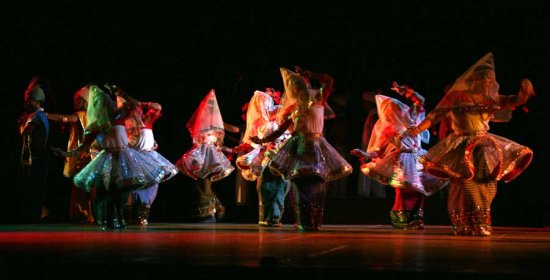 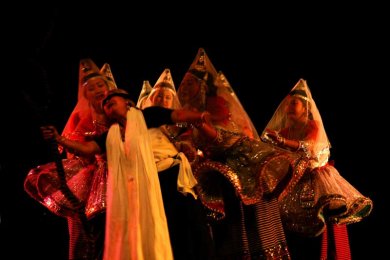
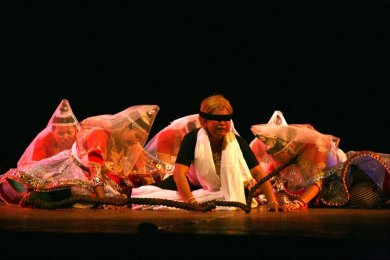
Photos courtesy: Chorus Repertory Theatre
Duryodhana, wounded with broken thigh, is lying on the floor. On hearing the news, Dhritarashtra, blind folded Gandhari, wives of Duryodhana and Durjaya enter the field. The cries of Duryodhana's widows rent the battlefield, Gandhari takes Duryodhana on her lap, Dhritarashtra places his palms on his body and the entire battlefield seems to resound with wailing of the bereaved family. Four wives of Duryodhana perform Manipuri dance, expressing their agony. Dressed in Manipuri costumes covering their faces with veils and gently executing the movements, they project their sorrow. The entire scene is soaked in tragedy. The royal king and the wives of Duryodhana are dressed in exquisite red, yellow, blue, white costumes, soldiers holding flags. In black costume enters Ashwathama and promises Duryodhana to kill the Pandavas. Duryodhana tells him not to. Meanwhile Durjaya, son of Duryodhana, is crowned as the king under a canopy and with blowing of the conch, we see Duryodhana dying in lap of Gandhari. He was satisfied that everything that he had wished, had happened during his reign. We see in the final scene Duryodhana going up to the heaven in Hansayaan, the vehicle of white swans with music and the blowing of the conch. And with Bharatavakya, as in Sanskrit plays, the play ends. It is a breathtaking scene that Ratan has created in this production. I had seen the play second time when I had accompanied Peter Brook and his troupe to Imphal. But this scene, Ratan explained to me, was specially created and has been introduced few years ago. It is a stunning visual. 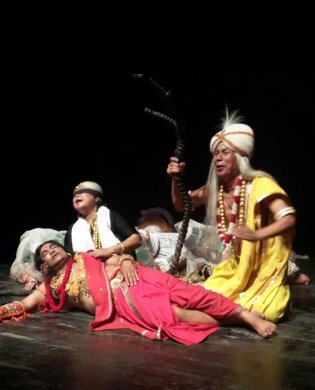 Duryodhana dying 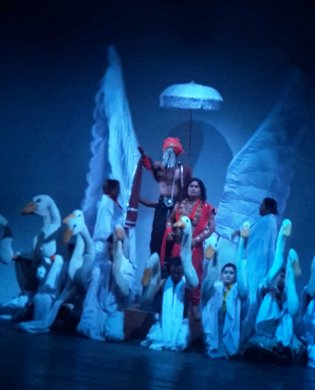 Hansayaan Photos: Dr. Sunil Kothari
Revisiting Urubhangam after three decades, I felt enriched. Ratan's lighting is like painting on a canvass. Bhogen who played Duryodhana is no more and few of the actors are new. But they all perform with such perfection that the play leaves a lasting impression. The sheer visual quality coupled with appropriate music offers a treat. The use of traditional Manipuri dance, Natasankirtan, and the rich costumes with excellent music composed by Ratan give his theatre a special identity. No wonder as a creative director, Ratan Thiyam continues to astound us.  Dr. Sunil Kothari is a dance historian, scholar, author and critic. He is honored with Padma Shri, Sangeet Natak Akademi award and Senior Critic Award from Dance Critics Association, NYC. Post your comments Please provide your name and email id when you use the Anonymous profile in the blog to post a comment. All appropriate comments posted with name & email id in the blog will also be featured in the site. |